This pub takes its name from its location in the Sirhowy Valley, and the pioneering tramway which ran along the course of High Street. The Sirhowy Valley runs from Tredegar to Newport. There are several explanations for the origin of the name. The most likely are Siriol-gwy, or pleasant water, and Sor-gwy, meaning angry water.
Prints and text about trade unionism.
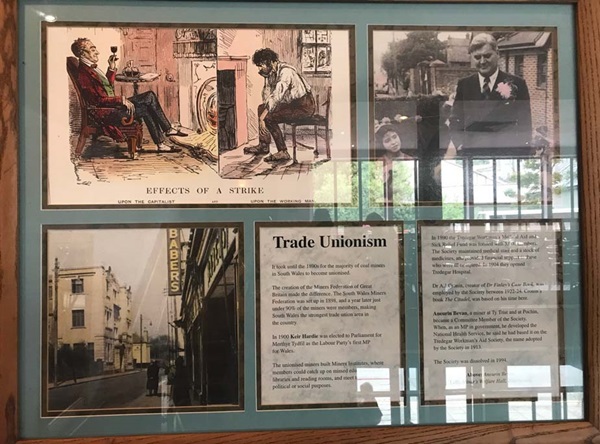
The text reads: It took until the 1890s for the majority of coal-miners in South Wales to become unionised.
The creation of the Miners Federation of Great Britain made the difference. The South Wales Miners Federation was set up in 1898, and a year later just under 90% of the miners were members, making South Wales the strongest trade union area in the country.
In 1900 Keir Hardie was elected to Parliament for Merthyr Tydfil as the Labour Party’s first MP for Wales.
The unionised miners built Miners Institutes, where members could catch up on missed education in the libraries and reading rooms, and meet together for political or social purposes.
In 1890 the Tredegar Workman’s Medical Aid and Sick Relief Fund was formed with 5,000 members. The society maintained medical staff and stock of medicines, and provided financial support to those who were ill or injured. In 1904 they opened Tredegar Hospital.
Dr AJ Cronin, creator of Dr Finlay’s Case Book, was employed by the society between 1922-24. Cronin’s book The Citadel, was based on his time here.
Aneurin Bevan, a miner at Ty Trist and at Pochin, became a committee member of the society. When, as an MP in government, he developed the National Health Service, he said he had based it on the Tredegar Workman’s Aid Society, the name adopted by the society in 1913.
The society was dissolved in 1994.
Above: Aneurin Bevan.
A print and text about the Rhos-nemydd estate and John Hodder Moggridge.
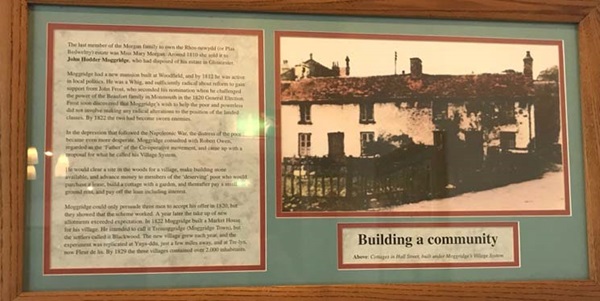
The text reads: The last member of the Morgan family to own the Rhos-nemydd (or Plas Bedweltty) estate was Miss Mary Morgan. Around 1810 she sold it to John Hodder Moggridge, who had disposed of his estate in Gloucester.
Moggridge had a new mansion built at Woodheld, and by 1812 he was active in local politics. He was a Whig, and sufficiently radical about reform to gain support from John Frost, who seconded his nomination when he challenged the power of the Beaufort family in Monmouth in the 1820 General Election. Frost soon discovered that Moggridge’s wish to help the poor and powerless did not involve making any radical alterations to the position of the landed classes. By 1822 the two had become sworn enemies.
In the depression that followed the Napoleonic War, the distress of the poor became even more desperate. Morridge consulted with Robert Owen, regarded as the ‘Father’ of the Co-operative movement, and came up with a proposal for what he called his Village System.
He would clear a site in the woods for a village, make building stone available, and advance money to members of the ‘deserving’ poor who would purchase a lease, build a cottage with a garden, and thereafter pay a small ground rent, and pay off the loan including interest.
Moggridge could only persuade three men to accept his offer in 1820, but they showed that the scheme worked. A year later the take up of new allotments exceeded expectation. In 1822 Moggridge built a Market House for his village. He intended to call it Tremoggridge (Moggridge Town), but the settlers called in Blackwood. The new village grew each year, and the experiment was replicated at Ynys-ddu, just a few miles away, and at Tre-lyn, now Fleur de lis. By 1829 the three villages contained over 2,000 inhabitants.
Above: Cottages in Hall Street, built under Moggridge’s Village System.
Prints and text about local villages.
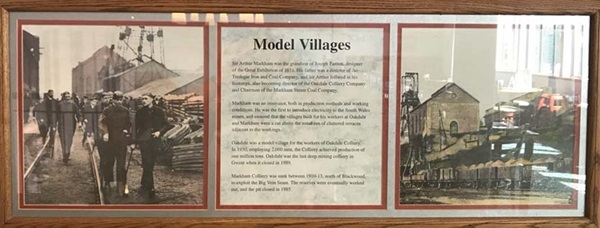
The text reads: Sir Arthur Markham was the grandson of Joseph Paxton, designer of the Great Exhibition of 1851. His father was a director of the Tredegar Iron and Coal Company, and Sir Arthur followed in his footsteps, also becoming director of the Oakdale Colliery Company and chairman of the Markham Steam Coal Company.
Markham was an innovator, both in production methods and working conditions. He was the first to introduce electricity to the South Wales mines, and ensured that the villages built for his workers at Oakdale and Markham were a cut above the usual run of cluttered terraces adjacent to the workings.
Oakdale was a model village for the workers of Oakdale Colliery. In 1930, employing 2,000 men, the colliery achieved production of one million tons. Oakdale was the last deep mining colliery in Gwent when it closed in 1989.
Markham Colliery was sunk between 1910-13, north of Blackwood, to exploit the Big Vein Scam. The reserves were eventually worked out, and the pit closed in 1985.
Prints and text about the Sirhowy Tramroad and railway.
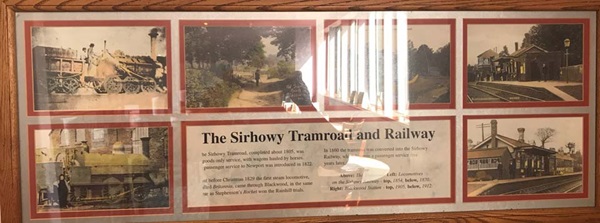
The text reads: The Sirhowy Tramroad, completed about 1805, was a goods only service, with wagons hauled by horses. A passenger service to Newport was introduced in 1822.
Just before Christmas 1829 the first steam locomotive, called Britannia, came through Blackwood, in the same year as Stephenson’s Rocket won the Rainhill trials.
In 1860 the tramroad was converted into the Sirhowy Railway, which became a passenger service five years later.
Above: The tramroad
Left: Locomotives on the Sirhowy Railway – top, 1854, below, 1870
Right: Blackwood Station – top, 1905, below, 1912.
Photographs of Oakdale Colliery, Blackwood, c1930.
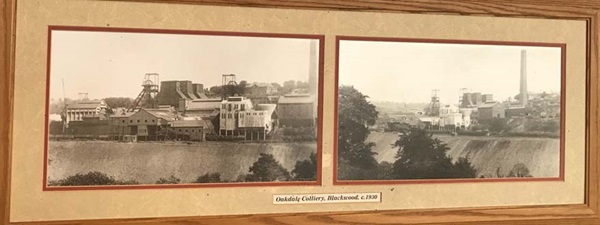
A photograph of Blackwood from Pontllanfraith, c1914.
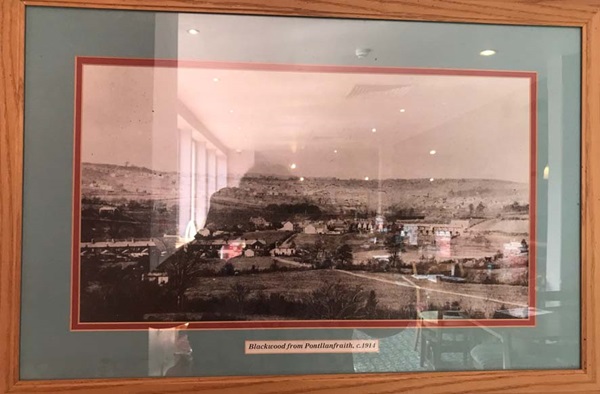
A photograph of Gelligroes Mill, Pontllanfraith, c1904.
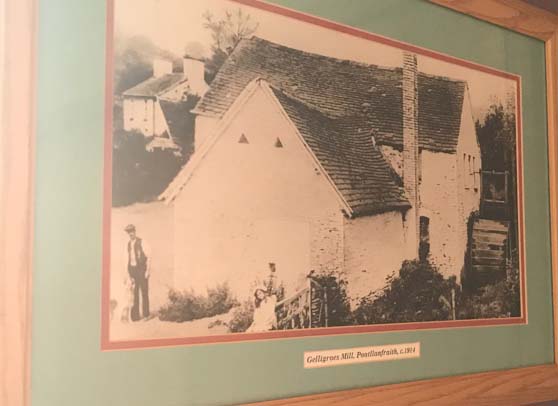
External photograph of the building – main entrance.
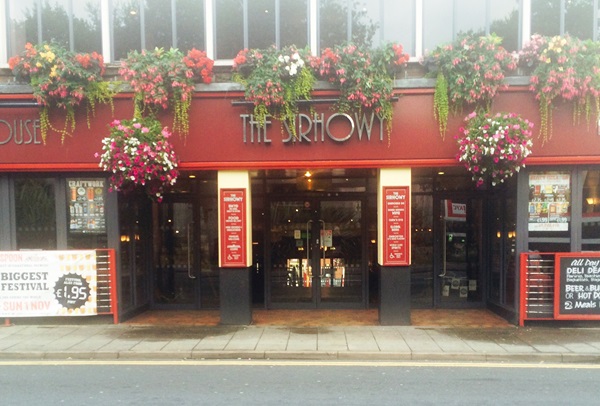
If you have information on the history of this pub, then we’d like you to share it with us. Please e-mail all information to: pubhistories@jdwetherspoon.co.uk